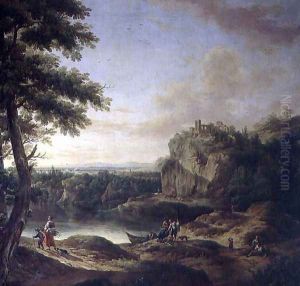Joseph Rosa or Roos Paintings
Joseph Rosa, also known as Joseph Johann Nepomuk Rosa or Joseph Roos, was a German painter born on August 15, 1726, in Munich, Germany. He came from a family of artists, including his brothers, who were also painters. Rosa is particularly known for his landscape and animal paintings, which were influenced by the Dutch animaliers of the 17th century and the Italianate landscape tradition.
Rosa received his initial training from his father, Johann Heinrich Roos, who was a significant painter of pastoral scenes and animals himself. Early in his career, Joseph Rosa's talent was recognized, and he was sent to Italy to further his studies. This period in Italy had a profound impact on his style and subject matter. Rosa spent time in Rome, where he was influenced by the dramatic landscape and the work of Italian artists. His paintings often depicted the Roman Campagna, the countryside surrounding Rome, characterized by its ruins and pastoral scenes.
After his time in Italy, Rosa returned to Germany, where he became a court painter for the Prince-Elector of the Palatinate in Düsseldorf. His work was highly regarded, and he received commissions from aristocratic patrons. Rosa's paintings often featured dramatic lighting and a strong sense of atmosphere, which were innovative at the time and contributed to his reputation as a master of landscape and animal painting.
Rosa's style is characterized by a realistic depiction of animals, particularly sheep, goats, and cattle, often set against evocative landscapes or amidst classical ruins. His use of light and shadow, as well as his attention to detail, helped to create a sense of depth and naturalism in his work. Joseph Rosa's paintings were not only popular in his own time but also had a lasting influence on the Romantic landscape painters of the 19th century.
Joseph Rosa died on October 23, 1805, in Vienna, Austria. His legacy is preserved in the collections of various European museums, where his works continue to be studied and admired for their contribution to the development of landscape and animal painting in the 18th century.
